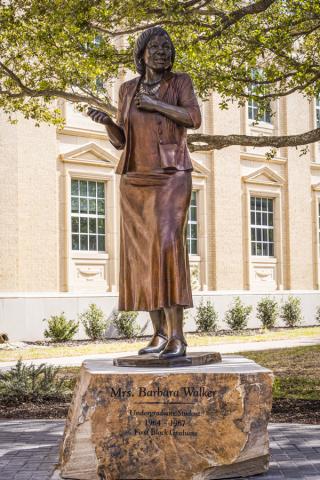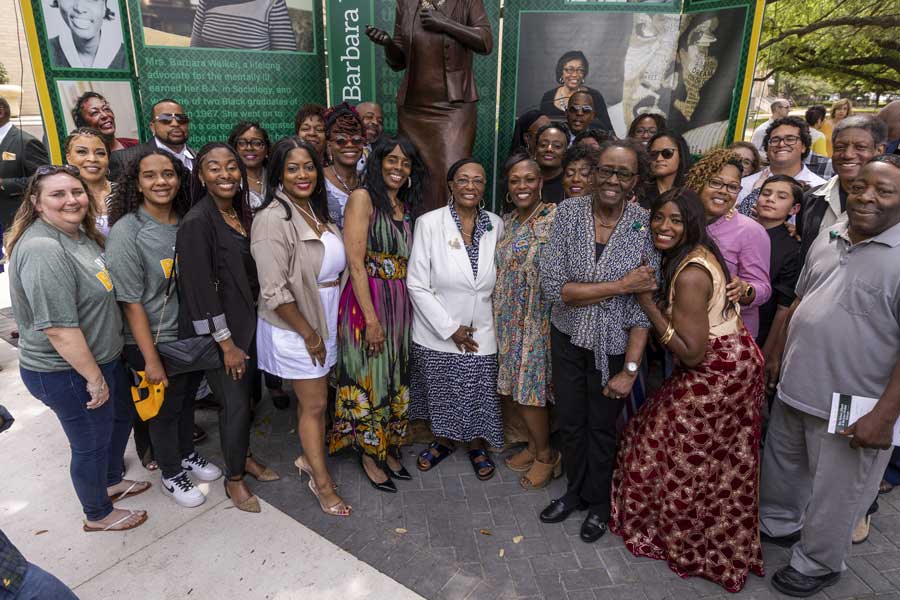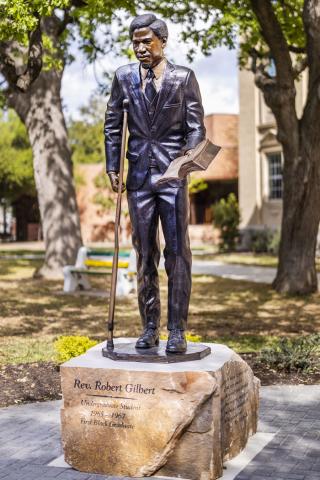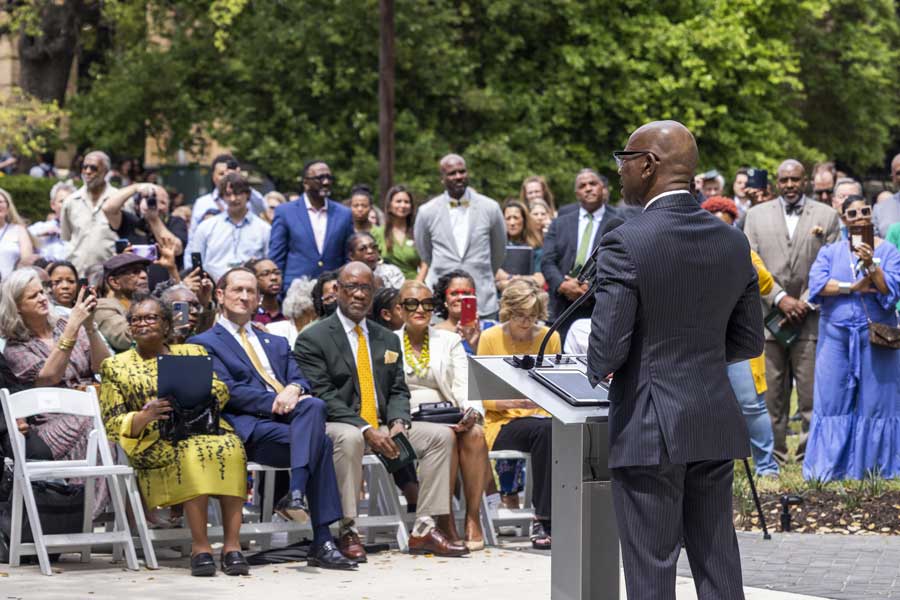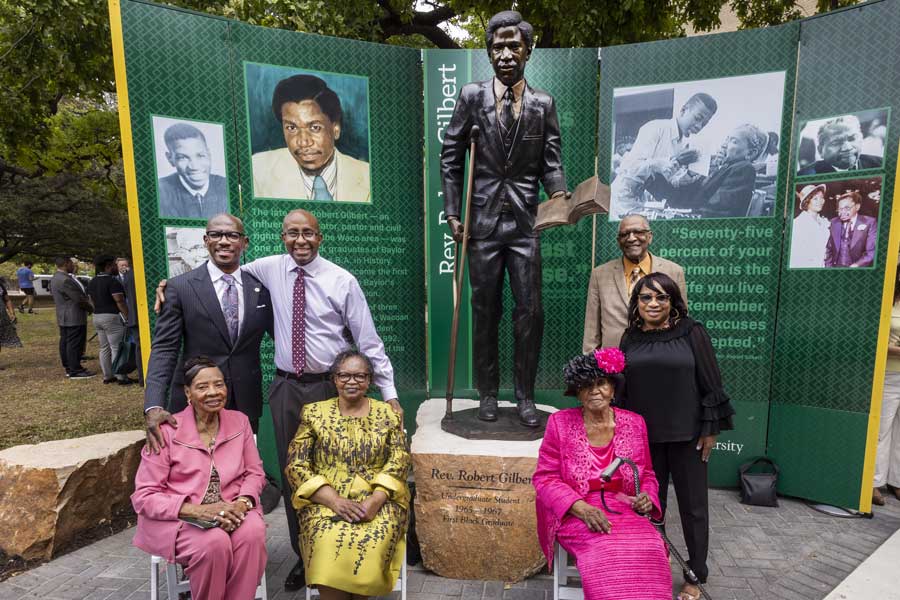Honoring the Past, Inspiring the Future
Statues of the first Black students to graduate from Baylor honor individuals who exemplify Baylor’s Christian mission
IN FRONT OF THE STEPS of the Tidwell Bible Building, statues of Reverend Robert Gilbert and Mrs. Barbara Walker were unveiled on April 4. A crowd of family and friends of the subjects were joined by Baylor students, staff, faculty and community members for the unveiling and dedication of the statues. Gilbert and Walker were the first Black graduates of Baylor University, receiving undergraduate degrees during the same ceremony in 1967.
Baylor’s landscape, past and future
When asked if Baylor seemed much changed from when she graduated 56 years ago, Barbara Walker responded, “Tremendously! Baylor has changed so much, just in the physical appearance.”
Baylor is in an exciting period of growth and renovation, evidenced only in part by the flurry of construction around campus. Residence Halls are being renovated and new buildings are rising up to facilitate excellence in both academic and athletic pursuits and to create points of connection for the Baylor Family. Anyone who has spent time on Baylor’s campus knows that its landscape is not static. These vibrant plans for the future are infused with an important reflective note.
In June 2020, Baylor’s Board of Regents announced the formation of the Commission on Historic Campus Representations, an advisory committee charged with providing guidance on presenting Baylor’s complete history, including its early leaders’ connections to slavery and the Confederacy. The work of this Committee responds to the goals of the University to foster a landscape in which racial equality is inextricably linked to its Christian mission — a mission that affirms the value, dignity and equality of every human being as created by God.
The statues of Robert Gilbert and Barbara Walker are a direct outcome of the Commission’s recommendation to recognize and honor the contributions of Black students, faculty and staff through physical representations on Baylor’s campus. The addition of Gilbert and Walker’s figures on campus acknowledges the first Black students to attend and graduate from Baylor, following the 1964 integration of the University.
“Through their perseverance in the face of tremendous adversity and injustice, they have paved the way for Baylor to grow into a multicultural welcoming place for thousands of new students each and every year,” Baylor President Linda A. Livingstone, Ph.D., remarked at the statue dedication ceremony.
Barbara Walker
At the ceremony, Barbara Walker dedicated her own statue to the memory of her mother. Walker was born in the small, all-Black town of Red Bird, Oklahoma. One of 13 children, she discovered a love of learning early in her childhood. Her pursuit of a college education was something that her own mother was not able to obtain.
“She was born in 1908, where there were very few opportunities for African-Americans to do anything. But my mother, being an educator, loved education, graduated the top in her class. It had always been her dream to go to college,” Walker said in her dedication remarks.
Walker sees her own educational accomplishments as sharing in and fulfilling her mother’s dreams, as well as her own.
Walker graduated from Porter High School in Oklahoma at 15 years old, having completed all requirements to graduate by grade 11. She did not waste any time moving to Waco, where she was accepted into Paul Quinn College, the oldest historically Black college in Texas.
She was only at Paul Quinn for one year before a faculty member recognized her academic abilities and encouraged her to transfer to Baylor University.
Relationships with other students and many professors at Baylor made a lasting impact on her life. Walker was not only the first Black female, and one of only two Black students to graduate in the same ceremony, she was the first Black student to join CHIS, a women’s service organization, and the first to perform in all University Sing.
She encourages students today to remember the example of Christ.
“Having that openness of mind to welcome and to just help people to feel accepted. I think that is one of the most beautiful things that Baylor students can do… Truly understanding what Christ’s mission was, and they can carry on that mission themselves through their behavior, not just through words, but through their actions. And just remembering that a lot of people have gone through a lot to make it possible to open those doors.”
In 1967, Walker graduated with a Bachelor of Arts in sociology. Her education at Baylor launched her on a 32-year career as a licensed clinical social worker where she served primarily with the California Department of Mental Health.
“Having that openness of mind to welcome and to just help people to feel accepted. I think that is one of the most beautiful things that Baylor students can do… Truly understanding what Christ’s mission was, and they can carry on that mission themselves through their behavior, not just through words, but through their actions.”
Today, Walker’s statue stands with her hand outstretched to Baylor’s students, faculty and staff. Her posture is inviting, leading and displaying the care and love for all human beings that she has demonstrated throughout her life and work.
“I hope I made a difference by being here, by being willing, from my perspective, just to accept people too.”
Robert Gilbert
The late Reverend Robert Gilbert was born in Waco in the shadows of a prominent Christian university that he could never hope to attend because of the color of his skin.
Gilbert was a man grounded in his faith and the pursuit of justice — he believed he could affect change to make his community more just and would not settle for good enough.
In a 1971 interview with Baylor’s Program for Oral History, Gilbert recounted the impact of the first time he encountered Black history. In the fifth grade, his teacher taught what was then called Negro History Week, a forerunner to what we now celebrate as Black History Month.
“This was one of the first times that I realized that Black people could achieve and do things that were great,” Gilbert said.
Learning that he, too, could change the world inspired him to pursue law. He enrolled at Paul Quinn College, but the school did not have a law program. It was during this time that Baylor was desegregating. Gilbert began classes toward a history degree and his path to law school in Summer 1965.
Gilbert did not have an easy Baylor experience. He felt a disconnected from his fellow students, and even some teachers, because he was Black. Gilbert also was suffering from psoriasis and arthritis, conditions that plagued his health and eventually required that he rely on the support of a crutch.
Despite this, he lived by the phrase “no excuses accepted” — a phrase that would become the title of his 1988 autobiography. His statue standing before Tidwell is a testament to this perseverance. As he leans on his crutch with one arm, the other holds the Bible. The book is opened to his favorite scripture, Philippians 4:13, “I can do all things through Christ who strengthens me.”
During his time at Baylor, Gilbert recognized he was called to ministry.
“There was a kind of yearning, and there was a kind of something burning in me and pressing me that you must do something, but it wasn’t quite clear,” he said in the 1971 interview. “And it wasn’t until I acknowledged my calling that I got relief from this.”
In the same graduation ceremony as Walker, Gilbert graduated with a Bachelor of Arts in history. In 1970, he became the first Black student to enroll in Baylor’s graduate program in the Department of Religion. In the following years, Gilbert lived in Waco, serving as the pastor of three churches. In 1976, he was the first Black person elected to the Waco Independent School District board. Gilbert was a pastoral leader to his community and one of the first civil rights leaders in Waco.
After the dedication of the statues, Gilbert’s wife, Elwayne Gilbert, described him as “A person that realized there should be justice for all.”
On the historic dedication of her husband’s statue, she said it is important for those at Baylor to know their history.
“I think it’s very important because without that knowledge, you have no foundation. You don’t know from whence you have come. So, it’s always good to know where you’ve been and where you’re going. And I think one of Robert’s statements was that he may have been the first, but don’t let him be the last.”
Putting form to history
Renown sculptor Benjamin Victor was immediately attracted to the stories of Walker and Gilbert when Baylor issued a public and competitive call for interested artists who wanted to be considered for creating the statues.
“Of course,” Victor said of learning about the projects, “I had never heard of Reverend Gilbert or Mrs. Walker. So, I started to study their histories a little bit and found some of his sermons online and found some interviews that she had done and speeches she had given. And I just thought, these are just two amazing people —unsung heroes that I would be honored and humbled to get to do sculptures of.”
Victor’s qualifications are impressive, to say the least. He became the youngest artist to have a sculpture displayed in the National Statuary Hall in the United States Capitol at the age of 26. In 2019, he earned the distinction of being the only living artist to have three works in the Statuary Hall. Importantly for the task of putting this pivotal moment of Baylor’s history into physical form, though, is Victor’s emphasis on storytelling for historically underrepresented groups.
Victor worked very closely with the families of Gilbert and Walker, including Barbara Walker herself, to learn about the individuals he would represent in his art. These conversations were instrumental in directing Victor’s vision of how to sculpt even the finest details, such as how the late Rev. Gilbert would lean on a crutch while preaching and how both Gilbert and Walker preferred to dress. Walker even sent a red dress of hers for Victor to use as a model.
Victor sculpted the statues in clay, then used a rubber-type mold to create bronze casts at a foundry. Each statue has a special patina finish that Victor developed. The two pieces were conceptualized and created in his Idaho studio, and he personally drove them to Waco for permanent placement.
Months of work culminated in two bronze statues that are 1.5-times life size set upon limestone bases, installed in front of the steps of the Tidwell Bible Building.
Future hopes embracing a complex past
The location of Gilbert and Walker’s statues has significance that reaches into the past and future. The Tidwell Bible Building now houses both the sociology and history departments, in which Walker and Gilbert earned their degrees. The building also contains Baylor’s religion department, including the classrooms for the religion courses every undergraduate Baylor student is required to take. Current and future Baylor students will be greeted by the statues of the first Black students to graduate from Baylor as they enter the building.
“Monuments have performative power,” Kenyatta Gilbert, B.A. ’96, son of Robert Gilbert, reminded the crowd at the dedication ceremony. “They say something about what we humans value and deem worthy of remembering. More than memorializing a person, monuments have profound theological implications. They say something about our conception of God, our beliefs and citizenship and religious freedom, and our vision for humanity’s collective future.”
The statues tell the story of Baylor’s past, are a reminder to not take for granted the strides the University has made, and encourage us to look to the future as we continue to shape the landscape of Baylor’s campus.
“It’s a tragedy that people were ever looked down upon just for their race or color of their skin, that they were physically harmed, or that all these prejudices and things existed. But even though it’s hard to study it sometimes, it’s important to. It’s important to recognize that and then it’s important to take those beautiful stories of inspiration from it so that we have something to go forward with,” Victor said of the stories and lives represented in the statues.
Gilbert and Walker’s statues honor individuals who exhibited in their life Baylor’s Christian mission — a mission that pursues justice, recognizes all of humanity as made in God’s image and seeks to emulate Christ’s love to others. Baylor’s changing landscape reflects the hope found in Christ’s transforming love.
